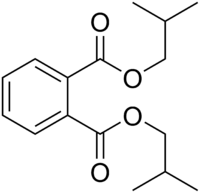- Diisobutyl phthalate
-
Diisobutyl phthalate  Diisobutyl phthalateOther namesDiisobutyl ester of phthalic acic, Bis(2-methoxypropyl)ester,1,2-benzenedicarboxylic acid, Di(isobutyl)-1,2-benzenedicarboxylate, DIBP, DiBP, Palatinol IC
Diisobutyl phthalateOther namesDiisobutyl ester of phthalic acic, Bis(2-methoxypropyl)ester,1,2-benzenedicarboxylic acid, Di(isobutyl)-1,2-benzenedicarboxylate, DIBP, DiBP, Palatinol ICIdentifiers CAS number 84-69-5 
PubChem 6782 ChemSpider 6524 
EC number 201-553-2 KEGG C15205 
RTECS number TI1225000 Jmol-3D images Image 1 - O=C(OCC(C)C)c1ccccc1C(=O)OCC(C)C
Properties Molecular formula C16H22O4 Molar mass 278.35 g/mol Appearance Colorless viscous liquid Density 1.038 g/cm3 Melting point -37 °C (236 K)
Boiling point 320 °C (593 K)
Solubility in water 1 mg/l at 20 °C log P 4.11 Vapor pressure 0.01 Pa at 20 °C Hazards R-phrases R50/53;R62;R63 S-phrases S36/37;S61 Main hazards Harmful (Xn), Dangerous for the environment (N) NFPA 704 Flash point 185 °C c.c. Autoignition
temperature400 °C  (verify) (what is:
(verify) (what is:  /
/ ?)
?)
Except where noted otherwise, data are given for materials in their standard state (at 25 °C, 100 kPa)Infobox references Diisobutyl Phthalate (DIBP) is prepared by esterification process of isobutanol and phthalic anhydride. Its structural formula is C6H4(COOCH2CH(CH3)2)2. Refractive index is 1.488 - 1.492 (20 °C, D).
DIBP is an odorless plasticizer and has excellent heat and light stability. It is the lowest cost plasticizer for cellulose nitrate. DIBP has lower density and freezing point than DBP (dibutyl phthalate, CAS No.: 84-74-2). It has similar properties as dibutyl phthalate and can be used as a substitute for it.
DIBP is used in nitro cellulose plastic, nail polish, explosive material, lacquer manufacturing and used with methyl methacrylate applications.
The concentration of a metabolite of DIBP (Mono-isobutyl phthalate or MIBP) has been steadily increasing in the urine of Americans over the period 1999-2008.[1]
Contents
Contamination
Products in Taiwan made from Hebo Natural Products Limited (禾博天然產物有限公司) of China contained ginger contaminated with DIBP, some 80,000 nutritional supplement capsules made with imported ginger powder were seized by the Public Health Department of Taiwan in June 2011.[2] In addition, soybean extract and olive leaf extract, both in powder form, were contaminated with DIBP and DBP. Concentration of DIBP in the ginger extract powder was found to be 33,100 parts per million (ppm), that of DIBP in the soybean extract powder, 41 ppm, and that of DIBP and DBP in the olive leaf extract powder, 768 ppm and 441 ppm, respectively.[3]
See also
- Phthalates
- Dibutyl phthalate (DBP)
References
- ^ Center for Disease Control Fourth National Report on Human Exposure to Environmental Chemicals, Updated Tables, February 2011 CDC Exposure Report.
- ^ http://www.etaiwannews.com/etn/news_content.php?id=1627491&lang=eng_news&cate_rss=TAIWAN_eng
- ^ http://www.chinapost.com.tw/taiwan/national/national-news/2011/06/15/306275/Plasticizer-found.htm China Post
External links
- International Chemical Safety Card 0829
- Human Health Hazard Assessment
- Diisobutyl phthalate degradation by Fenton treatment
Health issues of plastics and Polyhalogenated compounds (PHCs) Plasticizers: Phthalates Miscellaneous plasticizers Monomers Bisphenol A (BPA, in Polycarbonates) · Vinyl chloride (in PVC)Miscellaneous additives incl. PHCs Health issues Miscellanea PVC · Plastic recycling · Plastic bottle · Vinyl chloride · Dioxins · Polystyrene · Styrofoam · PTFE (Teflon) · California Proposition 65 · List of environmental health hazards · Persistent organic pollutant · European REACH regulation · Japan Toxic Substances Law · Toxic Substances Control ActCategories:- Phthalates
- Plasticizers
Wikimedia Foundation. 2010.

